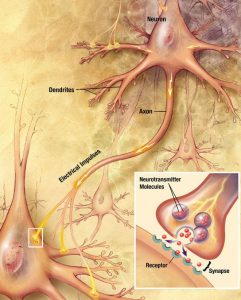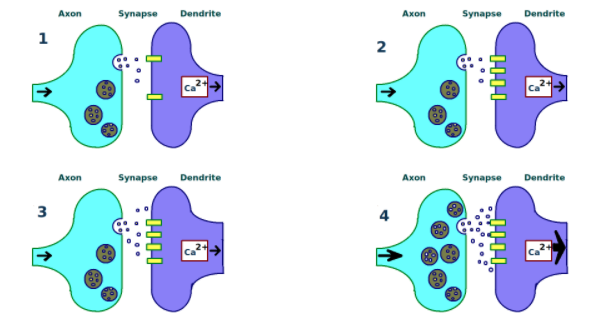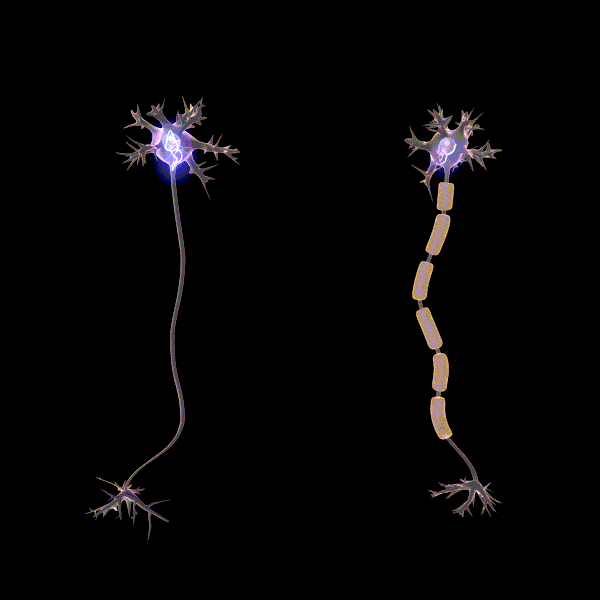8
Four key mechanisms, related to neuroplasticity, that support learning in the brain are synaptogenesis, long-term potentiation, myelination, and sleep.
Synaptogenesis
Synaptogenesis [1] refers to the making of connections between brain cells (i.e. neurons). The connections between neurons are called synapses. Neurons that are activated together (i.e. co-activated) form and strengthen their connections (i.e. synapses). “Hebbian plasticity [2] occurs during memory formation among engram cells at the synapse level” (Kim, Choi & Kaang, 2018). “Synaptic potentiation and depression are key players in mediating the creation of memory traces or engrams” (Takeuchi, Duszkiewicz & Morris, 2014).

Long-term Potentiation
Long-term potentiation (LTP) refers to making connections more permanent. Learning is reflected by changes in the connections between our brain cells but not all connections are the same. Some connections are rapid and temporary and support STM. Others are more durable and can last hours, days, or even a lifetime (i.e. LTM). For durable learning, we want to focus on how the longer-term connections can be made. A key (biological-functional) ingredient that underlies the formation of durable connections is believed to be long-term potentiation or LTP [3] – which involves the process of synthesizing or creating proteins [4]. Research suggests that LTP can be triggered by a specific pattern of activation much like a recipe (Fields, 2005). From animal studies and from studies that involved brain cells in petri dishes, a pattern was discovered: 3 x 2. Three ‘activations’ separated by two 10-minute gaps. What was critical is that the breaks were at least 10-minutes. At 10-minutes, it is believed that each activation is treated as a unique experience by the brain. And the more frequent we experience something, the higher priority it becomes for consolidation. Thus, 3 x 2, three activations of the same brain networks (memories) separated by 10 minutes, was found to be the minimum recipe for LTP and LTM. This knowledge is what underlies the Spaced Learning teaching strategy (Kelley & Whatson, 2013).

(1) A synapse is repeatedly stimulated. “A synapse is repeatedly stimulated, sending neurotransmitters from the axon terminal (left) across the synapse to the dendrites of a second neuron (right).” (2) More receptors are found on the dendrite. (3) More neurotransmitters are produced. (4) A stronger link between neurons is established. “Final stage of long term potentiation. Two nerves (left and right) are linked with a strong signal which works quickly. Scientists believe long term potentiation is the primary way that the brain learns.” (Source: Wikipedia, Creator: Tomwsulcer)
Myelination
Myelination refers to making connections more efficient. “It is well appreciated that myelination increases conduction velocity across individual axons” (Pan et al, 2020). Although the role myelin plays in learning is far from clear, a line of thought is that myelination enables us to make our frequently used networks (schema) efficient so they draw on fewer resources. As early research in biology revealed, myelin sheath forms around the axon to insulate it so less energy is lost when activated. Recent hypotheses state that “myelination could be strengthening specific projections in a manner akin to Hebbian plasticity, facilitating communication between spatially distributed neuronal ensembles” (Pan et al, 2020).

Sleep
Finally, more recent research revealed the critical role sleep plays in learning. An important discovery showed a mechanism during sleep where the (firing) activity patterns of neurons related to what had been learned during the day were ‘replayed’ in the brain areas of the hippocampus and the neocortex. This replay has been shown to play an important role in memory consolidation (Ji & Wilson, 2007; Breton & Robertson, 2013). The hippocampal replay can also occur during periods of wakeful rest and evidence shows that more replay can even predict memory performance (Schapiro et al. 2018). These findings show the importance of good sleep health to memory consolidation and learning. Moreover, while we don’t necessarily have to sleep during the day, we do need to give our brains a break – as breaks provide an opportunity to repeat and consolidate information from recent experiences.
References
Mechanisms of Learning
- Goelet, P., Castellucci, V. F., Schacher, S., & Kandel, E. R. (1986). The long and the short of long–term memory—a molecular framework. Nature, 322(6078), 419.
- Sutton, M. A., & Schuman, E. M. (2006). Dendritic protein synthesis, synaptic plasticity, and memory. Cell, 127(1), 49-58.
- *Farely, P. (2020 February 10). Long-Term Learning Requires New Nerve Insulation. Retrieved from https://www.ucsf.edu/news/2020/02/416621/long-term-learning-requires-new-nerve-insulation
Synaptogenesis
- Kim, J. I., Choi, D. I., & Kaang, B. K. (2018). Strengthened connections between engrams encode specific memories. BMB reports, 51(8), 369.
- Takeuchi, T., Duszkiewicz, A. J., & Morris, R. G. (2014). The synaptic plasticity and memory hypothesis: encoding, storage and persistence. Philosophical Transactions of the Royal Society B: Biological Sciences, 369(1633), 20130288.
Long-term Potentiation
- Fields, R. D. (2005). Making memories stick. Scientific American, 292(2), 74-81.
- Kelley, P., & Whatson, T. (2013). Making long-term memories in minutes: a spaced learning pattern from memory research in education. Frontiers in human neuroscience, 7, 589.
- Davis, R. L., & Zhong, Y. (2017). The biology of forgetting—a perspective. Neuron, 95(3), 490-503.
Myelination
- Pan, S., Mayoral, S. R., Choi, H. S., Chan, J. R., & Kheirbek, M. A. (2020). Preservation of a remote fear memory requires new myelin formation. Nature neuroscience, 23(4), 487-499.
- Farely, P. (2020 February 10). Long-Term Learning Requires New Nerve Insulation. Retrieved from https://www.ucsf.edu/news/2020/02/416621/long-term-learning-requires-new-nerve-insulation
Sleep
- Ji, D., & Wilson, M. A. (2007). Coordinated memory replay in the visual cortex and hippocampus during sleep. Nature neuroscience, 10(1), 100-107.
- Schapiro, A. C., McDevitt, E. A., Rogers, T. T., Mednick, S. C., & Norman, K. A. (2018). Human hippocampal replay during rest prioritizes weakly learned information and predicts memory performance. Nature communications, 9(1), 1-11.
Media Attributions
- Chemical_synapse_schema_cropped
- Screenshot 2020-11-05 at 10.37.26
- 600px-Saltatory_Conduction
- Synaptogenesis is, together with axonal rewiring -the axon is the projection of the body of a neuron that allows the formation of connections to other neurons in the brain networks and circuits- a form of structural neuroplasticity, in contrast to functional plasticity ↵
- The Hebbian behavior of a synapse or Hebbian learning (as the psychologist Donald Hebb described in the 40’s) refers to the fact that the input (stimulus) and output (response) of a synapse (i.e. in the presynaptic neuron and the postsynaptic neuron) have highly correlated outputs. This means that they are highly time-dependent, highly local (i.e. in a single synapse or connection), and strongly interactive which works to increase the efficacy of the synapse. In fact, Hebbian learning is used broadly nowadays to design machine learning algorithms. ↵
- Long Term Potentiation (LTP) is a biological property of synapses that is thought to underlie the formation of long-term memories and learning. It is a form of functional neuroplasticity in which connections are strengthened with use. In short, LTP is a response to repeated stimuli. When two neurons connect and are repeatedly activated together (e.g. repeated ‘crossing’ of a synapses from one neuron to the other), LTP is triggered to boost the efficacy of the connection – enabling the neurons to form a circuit (i.e. the neurons are more easily co-activated). ↵
- Research evidence indicates that the timescale of occurrence of the LTP phenomenon matches with the timescale of gene expression to synthesize proteins (principal elements that are used either as build-up units or to perform functions in the organism). This suggests that LTP (and learning) may be supported by and limited to a biological availability of resources to build proteins. ↵
